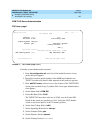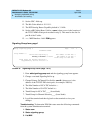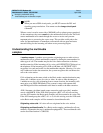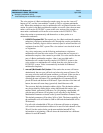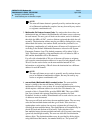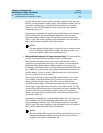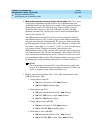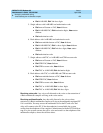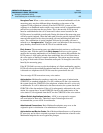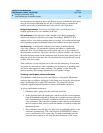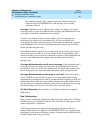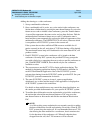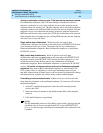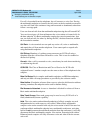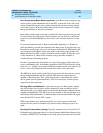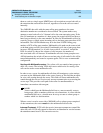
DEFINITY ECS Release 8.2
Administrator’s Guide
555-233-506
Issue 1
April 2000
Managing multimedia calling
255Understanding the multimedia complex
9
Hourglass Tone. When a voice station answers a converted multimedia call, the
answering party may hear different things depending on the nature of the
originator. If the origination is directly from an H.320 DVC system or if the
originator is an Enhanced mode complex on a remote switch, an immediate audio
path will not exist between the two parties. This is because the H.320 protocol
must be established after the call is answered. It takes several seconds for the
H.320 protocol to establish an audio path. During this interval the answering party
will hear special ringback. When the audio path exists the special ringback will be
removed and replaced with a short incoming call tone indicating that audio now
exists. The combination of special ringback followed by incoming call tone is
referred to as “
hourglass tone.” Hourglass tone is an indication to the answering
party that they should wait for the H.320 call to establish audio.
Early Answer. The answering party may administer their station to avoid hearing
hourglass tone. With the station form
Early Answer field set to y, the system
answers the incoming multimedia call on behalf of the station and establishes the
H.320 protocol. After audio path has been established, the call will then alert at
the voice station of the Basic complex destination. The station may then answer
by going off-hook and will have immediate audio path. No hourglass tone will be
heard by the answering party.
If the H.320 field is not set to y for the telephone of a Basic multimedia complex,
H.320 calls alert at the multimedia endpoint until the caller drops. If an H.320 call
is directed to a telephone with H.320 set to n, the system denies the call.
You can assign H.320 conversion to any voice station.
Authorization. Multimedia complexes require the same types of authorization
(COR/COS) as standard telephones. If a call is addressed to the voice extension,
the system checks the COR/COS of the telephone, whether the call is voice-only
or multimedia. If a call is addressed to the data extension, the system checks the
COR/COS of the data endpoint. If the call is subsequently redirected to the voice
station, the system does a second COR/COS check for the authorization of the
voice station. Calls originated from the PC use the COR/COS of the voice station.
Adjunct Switch Applications Interface . ASAI is not expected to support
call-association for data calls. Therefore Lucent Technologies does not
recommend that you use ASAI for multimedia.
Administered Connections. Basic Multimedia endpoints may serve as the
origination point or destination of an administered connection.
Authorization and Barrier Codes. Basic Mode multimedia users or off-premises
PC users may not be able to respond to prompts for authorization or barrier codes.
Multimedia endpoints do not recognize the prompts.



